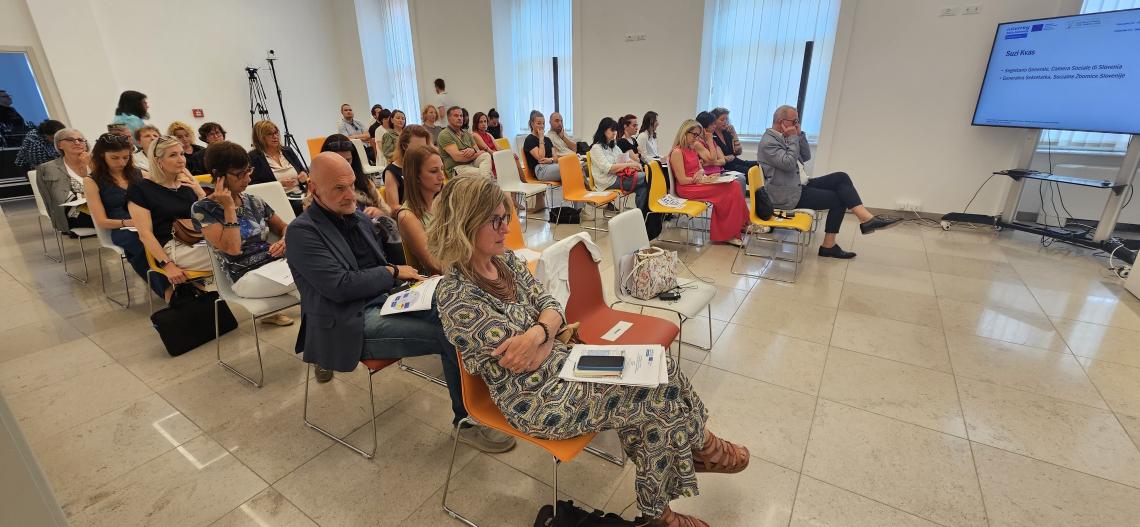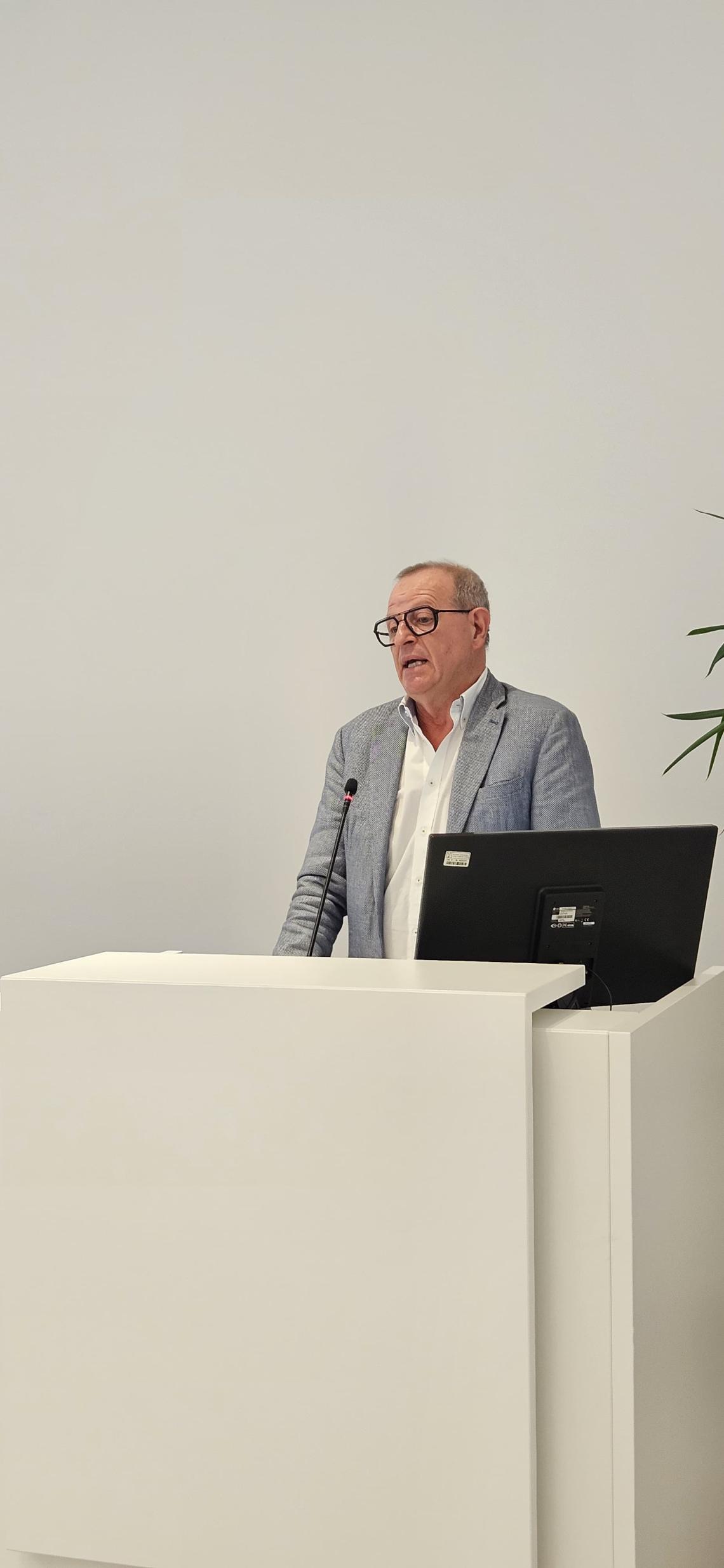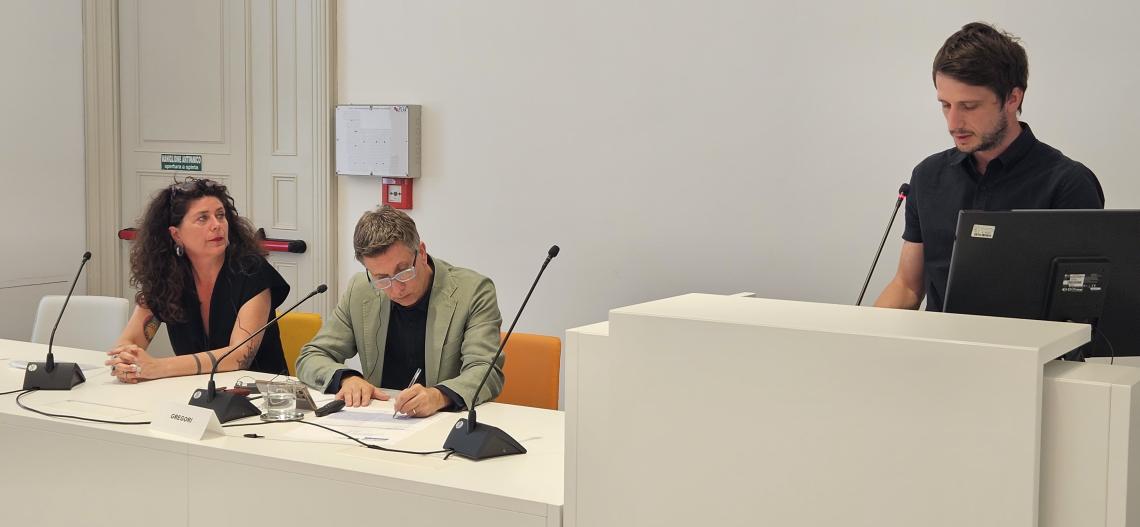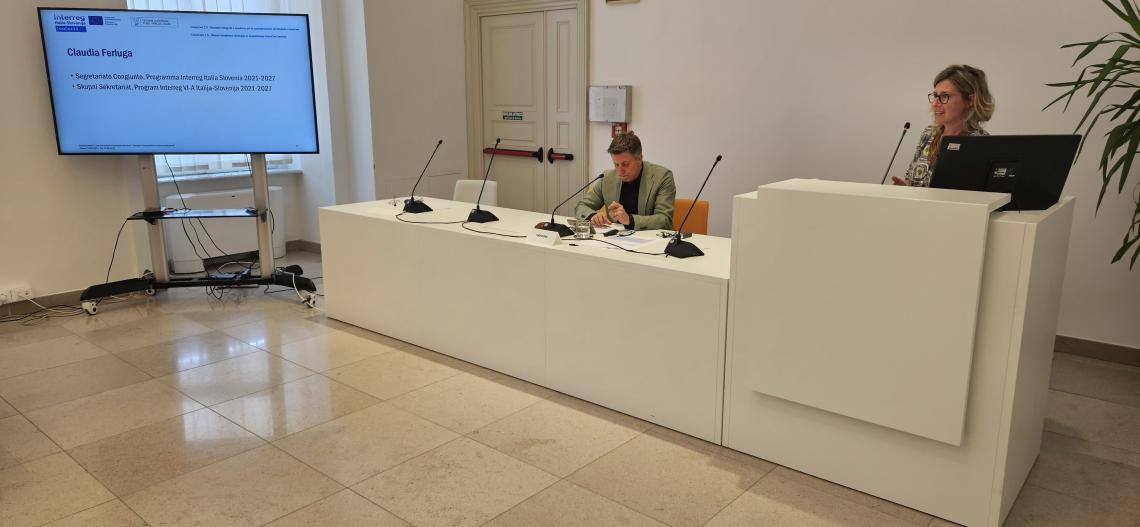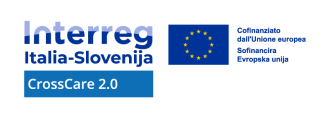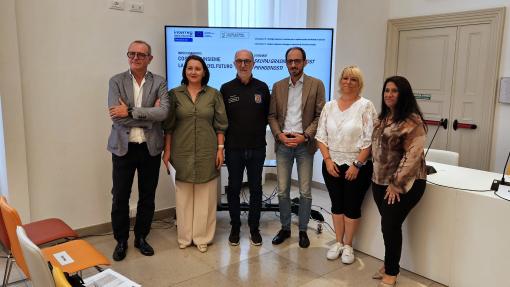On June 12th in Trieste at the Palazzo della Regione Friuli Venezia Giulia the final event of the CrossCare 2.0 project
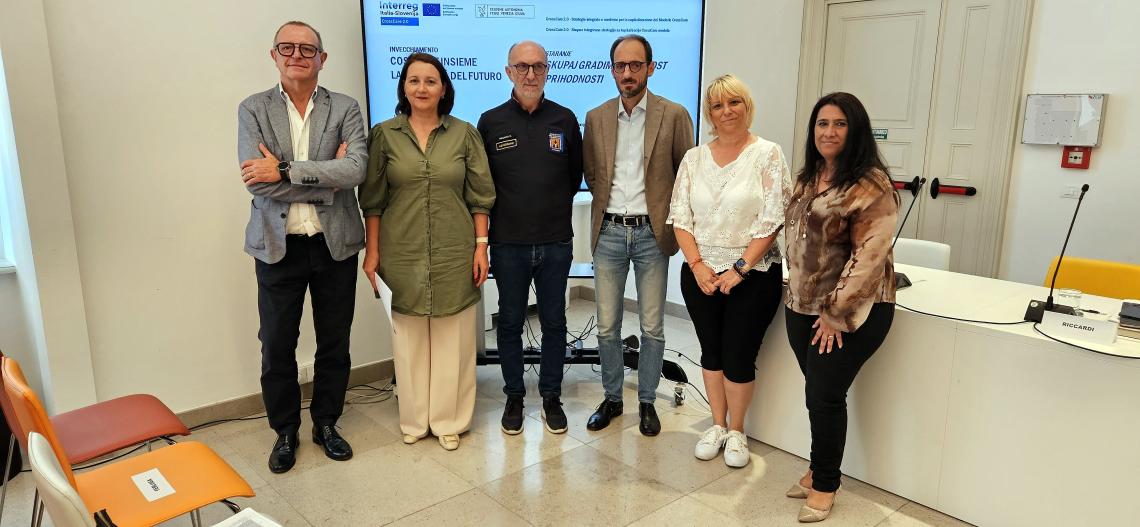
Aldo Pahor, Metka Velepec Šajn, Riccardo Riccardi, Massimo Tuzzato, Suzi Kvas, Anna La Diega
TRIESTE - The CrossCare 2.0 project reaches its culmination with the final event "Aging: Building the community of the future together", on June 12th 2025 at the Sala Predonzani of the Palazzo della Regione Friuli Venezia Giulia, Piazza dell'Unità d'Italia 1, in Trieste. An opportunity to present the results achieved, share the good practices developed and outline the future prospects of elderly care in the cross-border area.
Launched on October 1st 2023 and closing on June 30th, “CrossCare 2.0 - Integrated and shared strategies for the capitalization of the CrossCare Model” is co-financed by the Interreg VI-A Italy-Slovenia 2021-2027 Programme. The project addressed the challenge of population aging through cooperation between 15 partners from Friuli Venezia Giulia, Veneto and Slovenia, aiming to strengthen the governance of public-private decision-making processes and improve the coordination of social and health services for the care of the elderly.
The first-level partners, in addition to the lead partner Cooperativa Itaca, are Asp ITIS, Ipab Residenza per Anziani Giuseppe Francescon, DEOS celostna oskrba starostnikov d.o.o., Dom starejših občanov DSO Grosuplje e Azienda speciale Don Moschetta. Associated Partners: Azienda sanitaria Friuli Occidentale, Azienda unità locale Socio Sanitaria 4 Veneto Orientale, Comune di Portogruaro, Comune di Sacile, Federsanità ANCI Friuli Venezia Giulia, Servizio Sociale dei Comuni Livenza Cansiglio Cavallo, Združenje koncesionarjev domov za starejše, Zavod Aktivna Starost so.p., Azienda sanitaria universitaria Giuliano Isontina.
AGENDA
10:00-11:00, WELCOME GREETINGS:
Riccardo Riccardi, Regional Councillor for Health, Social Policies and Disability, Delegate for Civil Protection, Friuli Venezia Giulia Region
Suzi Kvas, General Secretary, Social Chamber of Slovenia
Massimo Tuzzato, Vicepresident of the Cooperativa Sociale Itaca, Lead partner
Aldo Pahor, President of Asp ITIS
Claudia Ferluga, Joint Secretariat, Interreg VI-A Italy-Slovenia Programme 2021-2027
11:00-12:30, A BRIDGE BETWEEN ITALY AND SLOVENIA FOR THE WELL-BEING OF THE ELDERLY:
CrossCare 2.0 - Integrated and shared strategies for the capitalization of the CrossCare Model, Azzurra Lanfranconi, Project manager, Cooperativa sociale Itaca
The cross-border guidelines of the CrossCare Model, Miha Kranic, Director DEOS - celostna oskrba starostnikov
Community Pacts in Friuli Venezia Giulia and Veneto, Chiara Perazzolo, Care manager, Residenza Francescon
Community Pacts in Slovenia, Metka Velepec Šajn, Director of Dom starejših občanov Grosuplje
The experience of social concierge, Francesco Mosetti, Care manager, Asp ITIS
The impact of the Protocols: Neuro-cognitive motion, Therapeutic arc/Polar pattern, Transcendental meditation, Maura Murgia, Care manager, Cooperativa sociale Itaca; Alessandra Parussolo, Social Worker, Servizio Sociale dei Comuni Livenza Cansiglio Cavallo; Raffaella Barro, Director Don Moschetta; Lorenza Fiorentino, Coordinator Centro diurno Municipality of Sacile
12:30-13:00, CONCLUSIONS:
Anna La Diega, General Director Cooperativa Sociale Itaca
Maria Teresa Agosti, General Director Asp ITIS
Claudia Ferluga, Joint Secretariat, Interreg VI-A Italy-Slovenia Programme 2021-2027
ADDED VALUE: INNOVATION AND BENEFITS FOR THE COMMUNITY
CrossCare 2.0 stands out for its innovative approach to elderly care, centered on the creation of a more effective, integrated and personalized care system. The project introduced the CrossCare 2.0 Model, which puts the elderly person and their family at the center, promoting collaboration between professionals from different disciplines and continuity of care between services. A key element of this innovation is the figure of the Care Manager, who coordinates the care path and guarantees support tailored to the needs of each individual.
Furthermore, CrossCare 2.0 has promoted the creation of Community Pacts, territorial agreements that involve a plurality of actors (public, private, third sector entities, citizens) to build a support network around the elderly and promote active aging. This approach has generated concrete benefits for the elderly, improving their quality of life, promoting autonomy and combating social isolation. At the same time, the project strengthened the capacity of communities to care for their elderly, creating a more participatory and sustainable welfare model.
GOALS AND RESULTS OF THE CROSSCARE 2.0 PROJECT
CrossCare 2.0 pursued a series of strategic objectives to improve care for the elderly in the cross-border area. The results achieved in the territories of Sacile, Portogruaro, Caorle, Ljubljana and Grosuplje testify to the effectiveness of the approach adopted and the positive impact of the project on the communities involved.
STRENGTHENING COOPERATION AND GOVERNANCE. The aim was to strengthen cooperation and governance of public-private decision-making processes between institutions and key operators of social and health services for the care of the elderly in the Programme Area. The results led to the creation of a cross-border network of 15 partners active in the elderly care sector, to the implementation of coordination and collaboration mechanisms between the different institutional and organizational levels, to the promotion of constant dialogue between public, private and third sector bodies for the definition of more effective policies and services.
DEVELOPMENT AND IMPLEMENTATION OF THE CROSSCARE 2.0 MODEL. The aim was to develop and implement a model of integrated and personalized care for the elderly and their family, capable of responding to the specific needs of each individual. The results led to the definition of the CrossCare 2.0 Model, an innovative approach that places the elderly person and their quality of life at the center; to the testing of the Model in different territorial contexts, with the involvement of operators, elderly people and caregivers; to the evaluation of the effectiveness of the Model and identification of good practices for its replicability.
IMPLEMENTATION OF COMMUNITY PACTS. If the objective was to promote the creation of Community Agreements at a local level to foster social cohesion and build a support network around the elderly person, the results led to the signing of Community Pacts in various locations in Friuli Venezia Giulia, Veneto and Slovenia, with the participation of over 50 institutions and organizations. But also to the activation of participatory processes that involved citizens, associations, social and health services in the definition of shared actions, and to the improvement of home care, promotion of active aging, support for caregivers and combating social isolation thanks to the action of Community Pacts.
TRAINING AND STRENGTHENING OF SKILLS. The expected objective was to strengthen the skills of operators and caregivers to ensure quality care and promote innovation in the sector. The results achieved led to the organization of joint training courses on CrossCare® methods and approaches, aimed at social health workers and volunteers; to the dissemination of good practices and innovative tools for the care of the elderly, through the Neuro-cognitive Motor Protocols, Therapeutic Arc/Polar Pattern, Transcendental Meditation; to the increase of awareness on the theme of aging and on the need for a person-centered approach.
The CROSSCARE MODEL 2.0 is based on a series of key principles, including the centrality of the person, the elderly person is placed at the center of the care process, taking into account their needs, desires and expectations; the multidisciplinary approach, care is provided by a team of professionals from different disciplines (doctors, nurses, social workers, etc.) who work in a coordinated manner; continuity of care, continuous care of the elderly person is guaranteed, from home to residential facilities, ensuring a smooth transition between the different levels of care; the involvement of the family, which is considered an integral part of the care system and is actively involved in the decision-making process; the enhancement of local resources, resources present in the community (volunteering, associations, social services, etc.) are activated and networked to provide complete support to the elderly person.
COMMUNITY PACTS, created as part of CrossCare 2.0, represent a significant innovation in the elderly care landscape. These are territorial agreements that involve a variety of actors (public, private, third sector entities, citizens) and that aim to build a support network around the elderly person. The Pacts have supported the mapping of needs and resources, the needs of the elderly and the resources available in the area to respond to these needs have been identified; the definition of shared actions, concrete actions have been developed to improve home care, promote active aging, support caregivers and prevent social isolation; the strengthening of collaboration, collaboration between the various actors involved has been promoted, creating an integrated and widespread support network; community awareness, community awareness on the topic of aging and the importance of taking care of the elderly has been increased.
The experience of the SOCIAL CONCIERGE carried out in Trieste is that of a community intervention model that aims to support frail and vulnerable people, especially the elderly, through the creation of a proximity network and the provision of support, listening and orientation services. The experience focused on taking charge of frail elderly residents in the Barriera Vecchia district. During the project, it recorded around 600 contacts, built a solid network of volunteers with different skills, carried out a detailed mapping of the needs of the territory and implemented a series of concrete actions. Among these, the organization of gymnastic activities to promote physical well-being, socialization meetings to combat isolation and the definition of personalized intervention plans to respond effectively to the specific needs of each elderly person stand out. The Social Concierge is daily alternated by professionals from public bodies who have signed the Community Pacts and volunteers from the proximity network.
CrossCare 2.0 has shown that it is possible to build a more effective and sustainable care model, capable of responding to the challenges of an aging population. The results achieved are the result of intense collaborative work between Italian and Slovenian partners, who have made their skills and resources available to achieve a common goal: improving the quality of life of the elderly.
The final event in Trieste represents an important moment to take stock of the work done and to look to the future. The challenge of an aging population is destined to become increasingly relevant in the coming years, and it will be essential to continue investing in innovative and integrated care models. CrossCare 2.0 has laid the foundations for positive change, but it is necessary to continue on this path, strengthening collaboration between the various actors and promoting a culture of care and solidarity.
